 With the onset of the pandemic in early 2020, stock markets around the world fell dramatically, with many indices falling by 30% or more. In the USA, the Dow Jones fell by 37% and the Nasdaq fell by 30%. In the UK, the FTSE 100 fell by 33% and the FTSE 250 by 41%.
With the onset of the pandemic in early 2020, stock markets around the world fell dramatically, with many indices falling by 30% or more. In the USA, the Dow Jones fell by 37% and the Nasdaq fell by 30%. In the UK, the FTSE 100 fell by 33% and the FTSE 250 by 41%.
But with a combination of large-scale government support for their economies, quantitative easing by central banks and returning confidence of investors, stock markets then made a sustained recovery and have continued to grow strongly since – until recently, that is.
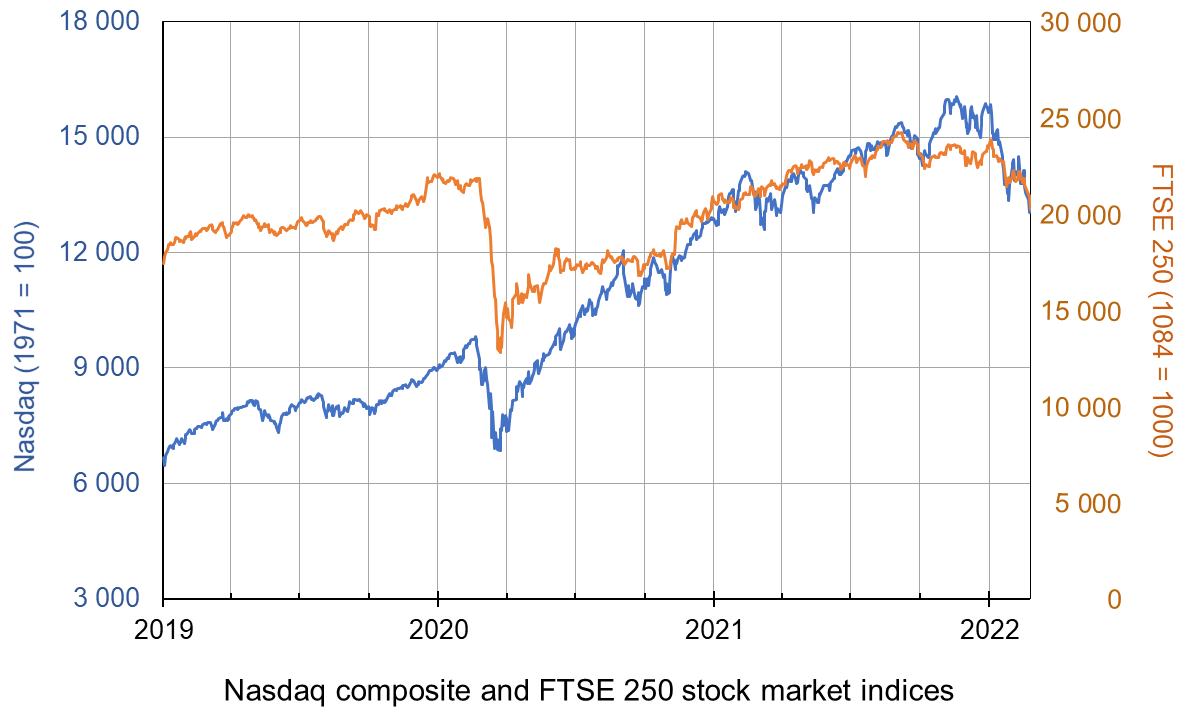
With inflation well above target levels, central banks have ended quantitative easing (QE) or have indicated that they soon will. Interest rates are set to rise, if only slowly. The Bank of England raised Bank Rate from its historic low of 0.1% to 0.25% on 16 December 2021 and ceased QE, having reached its target of £895 billion of asset purchases. On 4 February 2022, it raised Bank Rate to 0.5%. The Fed has announced that it will gradually raise interest rates and will end QE in March 2022, and later in the year could begin selling some of the assets it has purchased (quantitative tightening). The ECB is not ending QE or raising interest rates for the time being, but is likely to do so later in the year.
At the same time economic growth is slowing, leading to fears of stagflation. Governments are likely to dampen growth further by tightening fiscal policy. In the UK, national insurance is set to rise by 1.25 percentage points in April.
The slowdown in growth may discourage central banks from tightening monetary policy more than very slightly. Indeed, in the light of its slowing economy, the Chinese central bank cut interest rates on 20 January 2022. Nevertheless, it is likely that the global trend will be towards tighter monetary policy.
The fears of slowing growth and tighter monetary and fiscal policy have led many stock market investors to predict an end to the rise in stock market prices – an end to the ‘bull run’. This belief was reinforced by growing tensions between Russia and NATO countries and fears (later proved right) that Russia might invade Ukraine with all the turmoil in the global economy that this would entail. Stock market prices have thus fallen.
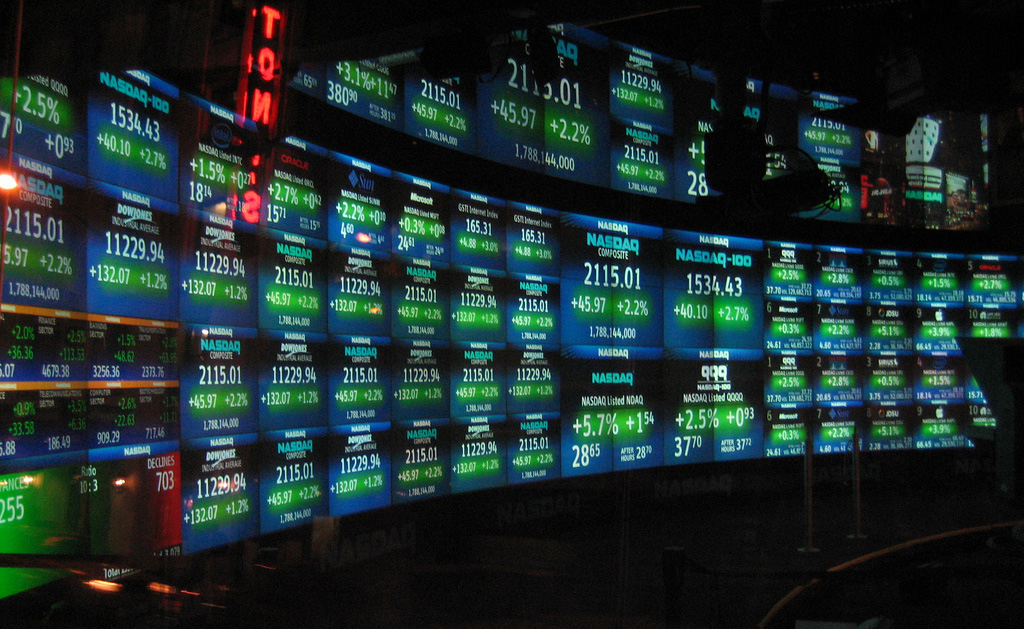 The key question is what will investors believe. If they believe that share prices will continue to fall they are likely to sell. This has happened since early January, especially in the USA and especially with stocks in the high-tech sector – such stocks being heavily represented in the Nasdaq composite, a broad-based index that includes over 2500 of the equities listed on the Nasdaq stock exchange. From 3 January to 18 February the index fell from 15 833 to 13 548, a fall of 14.4%. But will this fall be seen as enough to reflect the current economic and financial climate. If so, it could fluctuate around this sort of level.
The key question is what will investors believe. If they believe that share prices will continue to fall they are likely to sell. This has happened since early January, especially in the USA and especially with stocks in the high-tech sector – such stocks being heavily represented in the Nasdaq composite, a broad-based index that includes over 2500 of the equities listed on the Nasdaq stock exchange. From 3 January to 18 February the index fell from 15 833 to 13 548, a fall of 14.4%. But will this fall be seen as enough to reflect the current economic and financial climate. If so, it could fluctuate around this sort of level.
However, some may speculate that the fall has further to go – that indices are still too high to reflect the earning potential of companies – that the price–earnings ratio is still too high for most shares. If this is the majority view, share prices will indeed fall.
Others may feel that 14.4% is an overcorrection and that the economic climate is not as bleak as first thought and that the Omicron coronavirus variant, being relatively mild for most people, especially if ‘triple jabbed’, may do less economic damage than first feared. In this scenario, especially if the tensions over Ukraine are diffused, people are likely to buy shares while they are temporarily low.
 But a lot of this is second-guessing what other people will do – known as a Keynesian beauty contest situation. If people believe others will buy, they will too and this will push share prices up. If they think others will sell, they will too and this will push share prices down. They will all desperately wish they had a crystal ball as they speculate how people will interpret what central banks, governments and other investors will do.
But a lot of this is second-guessing what other people will do – known as a Keynesian beauty contest situation. If people believe others will buy, they will too and this will push share prices up. If they think others will sell, they will too and this will push share prices down. They will all desperately wish they had a crystal ball as they speculate how people will interpret what central banks, governments and other investors will do.
Articles
Questions
- What changes in real-world factors would drive investors to (a) buy (b) sell shares at the current time?
- How does quantitative easing affect share prices?
- What is meant by the price-earnings ratio of a share? Is it a good indicator as to the likely movement of that share’s price? Explain.
- What is meant by a Keynesian beauty contest? How is it relevant to the stock market?
- Distinguish between stabilising and destabilising speculation and illustrate each with a demand and supply diagram. Explain the concept of overshooting in this context.
- Which is more volatile, the FTSE 100 or the FTSE 250? Explain.
- Read the final article linked above. Were the article’s predictions about the Fed meeting on 26 January borne out? Comment.
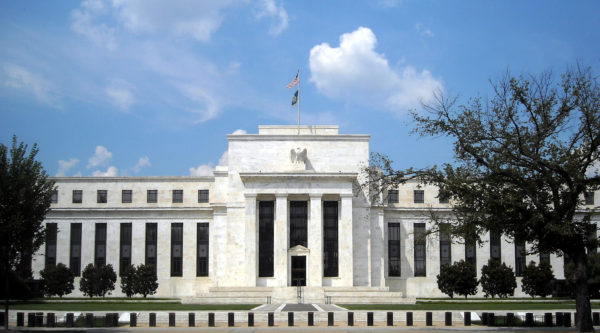 The monetary policy mandates of central banks have an impact on all our lives. While the terminology might not be familiar to many outside economics, their impact is, however, undeniably important. This is because they set out the objectives for the operation of monetary policy. Adjustments to interest rates or the growth of the money supply, which affect us all, reflect the mandate given to the central bank.
The monetary policy mandates of central banks have an impact on all our lives. While the terminology might not be familiar to many outside economics, their impact is, however, undeniably important. This is because they set out the objectives for the operation of monetary policy. Adjustments to interest rates or the growth of the money supply, which affect us all, reflect the mandate given to the central bank.
Since 1977 the mandate given to the Federal Reserve (the US central bank) by Congress has been to promote effectively the goals of maximum employment, stable prices, and moderate long-term interest rates. This mandate has become known as the dual mandate because it emphasises both employment and stable prices. Since 2012, the Federal Reserve’s Open Market Committee has issued an annual statemenent of its long-run goals. The latest was published in January 2019. Since this time, the Federal Reserve has explicitly set the ‘longer-run goal for inflation’ at 2 per cent. It has also emphasised that it would be ‘concerned’ if the inflation rate was persistently above or below this level.
In November 2018 the Federal Reserve began a review of its monetary policy strategy, its tools and how it communicates monetary policy. The review is being conducted within the guidelines that its statutory mandate gives and as well as the longer-term inflation goal of 2 per cent. However, one of the issues being addressed by the review is how the operation of monetary policy can avoid the rate of inflation frequently undershooting 2 per cent, as it has done since the financial crisis of the late 2000s and the introduction of the 2 per cent inflation rate target.
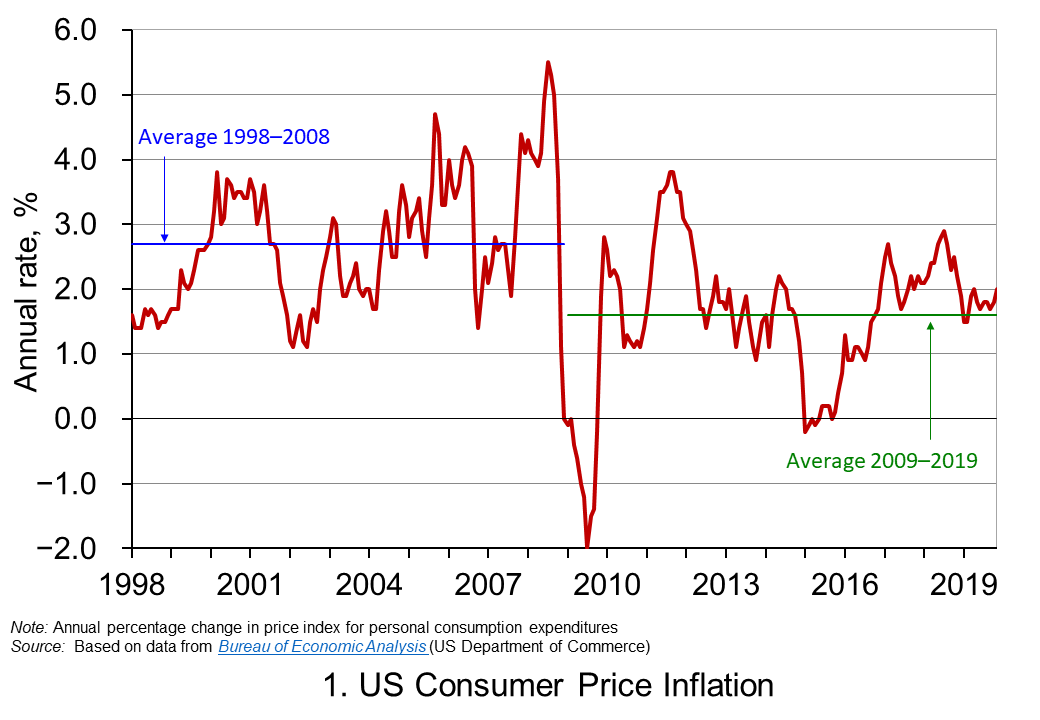 Chart 1 shows the annual rate of consumer price inflation in the US since 1998. It helps to illustrate the concern that low inflation rates can become entrenched. The chart shows that, while the average inflation rate from 1998 to 2008 was 2.7 per cent, from 2009 the average has been only 1.6 per cent. Interestingly, the average since 2012, when the explicit 2 per cent goal was introduced, to the present day is also 1.6 per cent. (Click here to download the PowerPoint chart.)
Chart 1 shows the annual rate of consumer price inflation in the US since 1998. It helps to illustrate the concern that low inflation rates can become entrenched. The chart shows that, while the average inflation rate from 1998 to 2008 was 2.7 per cent, from 2009 the average has been only 1.6 per cent. Interestingly, the average since 2012, when the explicit 2 per cent goal was introduced, to the present day is also 1.6 per cent. (Click here to download the PowerPoint chart.)
The concern going forward is that the natural or neutral rate of interest, which is the policy rate at which the rate of inflation is close to its target level and the level of output is close to its potential level, is now lower than in the recent past. Hence, when the next downturn occurs there is likely to be less room for cutting interest rates. Hence, the review is looking, in essence, to future-proof the conduct of monetary policy.
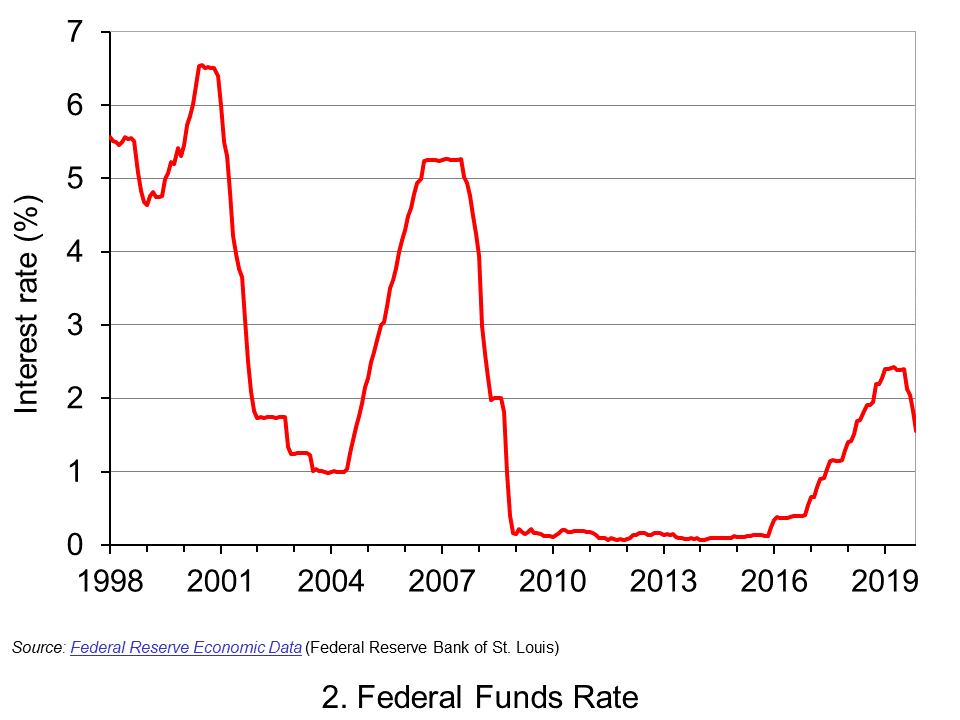 Chart 2 shows the Federal Fund rate since 1998. This is the rate at which commercial banks lend to each other the reserve balances they hold at the Federal Reserve in order to meet their reserve requirements. The Federal Reserve can affect this rate through buying or selling government securities. If it wants to drive up rates, it can sell holdings of government securities and reduce the money supply. If it wants to drive rates down, it can buy government securities and increase the money supply. The effects then ripple through to other interest rates and, in turn, aggregate demand and inflation. (Click here to download a copy of the PowerPoint chart.)
Chart 2 shows the Federal Fund rate since 1998. This is the rate at which commercial banks lend to each other the reserve balances they hold at the Federal Reserve in order to meet their reserve requirements. The Federal Reserve can affect this rate through buying or selling government securities. If it wants to drive up rates, it can sell holdings of government securities and reduce the money supply. If it wants to drive rates down, it can buy government securities and increase the money supply. The effects then ripple through to other interest rates and, in turn, aggregate demand and inflation. (Click here to download a copy of the PowerPoint chart.)
We can see from Chart 2 the dramatic cuts made by the Federal Reserve to interest rates as the financial crisis unfolded. The subsequent ‘normalisation’ of the Federal Funds rate in the 2010s saw the Federal Funds Rate rise to no higher than between 2.25 and 2.5 per cent. Then in 2019 the Federal Reserve began to cut rates again. This was despite historically-low unemployment rates. In November 2019 the unemployment rate fell to 3.5 per cent, its lowest since 1969. This has helped fuel the argument among some economists and financiers, which we saw earlier, that that the natural (or neutral) interest rate is now lower.
If the natural rate is lower, then this raises concerns about the effectiveness of monetary policy in future economic downturns. In this context, the review is considering ways in which the operation of monetary policy would be able to prevent the rate of inflation consistently undershooting its target. This includes a discussion of how the Fed can prevent inflationary expectations becoming anchored below 2 per cent. This is important because, should they do so, they help to anchor the actual rate of inflation below 2 per cent. One possibility being considered is an inflation make-up strategy. In other words, a period of below-target inflation rates would need to be matched by a period where inflation rates could exceed the 2 per cent target in order that the long-term average of 2 per cent is met.
An inflation make-up policy would work like forward guidance in that people and markets would know know that short-term interest rates would be kept lower for longer. This would then help to force longer-term interest rates lower as well as providing people and businesses with greater certainty that interest rates will be lower for longer. This could help to encourage spending, raise economic growth and prevent inflation from overshooting its target for any extensive period of time.
An inflation make-up strategy would, in part, help to cement the idea that the inflation target is effectively symmetrical and that 2 per cent is not an upper limit for the inflation rate. But, it would do more than that: it would allow the Fed to deliberately exceed the 2 per cent target.
An inflation make-up strategy does raise issues. For example, how would the Fed determine the magnitude of any inflation make-up and for how long would a looser monetary stance be allowed to operate? In other words, would an inflation make-up strategy be determined by a specific rule or formula? Or, would the principle be applied flexibly? Finally, could a simpler alternative be to raise the target rate itself, given the tendency to undershoot the 2 per cent target rate? If so, what should that the rate be?
We should know by the end of 2020 whether the Federal Reserve will adopt, when necessary, an inflation make-up monetary policy.
Articles
Questions
- What do you understand by the monetary policy mandate of a central bank?
- Explain the ways in which the monetary policy mandate of the central bank affects our everyday lives.
- Why are inflation-rate expectations important in determining actual inflation rates?
- Why is the Federal Reserve concerned about its ability to use monetary policy effectively during future economic downturns?
- Discuss the economic arguments for and against central banks operating strict inflation-rate targets.
- Does the case for adopting an inflation make-up monetary policy mandate show that the argument for inflation-rate targeting has been lost?
- What do you understand by the idea of a natural or neutral policy interest rate? Would the actual rate be expected to be above or below this if the rate of inflation was below its target level?
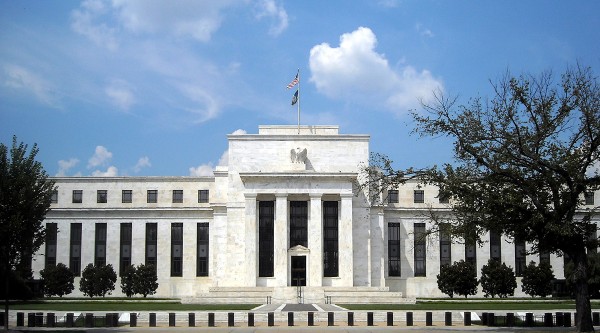 Interest rates are the main tool of monetary policy and have a history of being an effective tool in creating macroeconomic stability. There has been much discussion since the end of the financial crisis concerning when interest rates would rise in the US (and the UK) and for the US, the case is stronger, given its rate of growth, which has averaged at 2.2% per annum since June 2009.
Interest rates are the main tool of monetary policy and have a history of being an effective tool in creating macroeconomic stability. There has been much discussion since the end of the financial crisis concerning when interest rates would rise in the US (and the UK) and for the US, the case is stronger, given its rate of growth, which has averaged at 2.2% per annum since June 2009.
As in the UK, the question of ‘will rates rise?’ has a clear and certain answer: Yes. The more challenging question is ‘when?’. Much of the macroeconomic data for the US is promising, with positive economic growth (and relatively strong in comparison to the UK and Eurozone), a low unemployment rate and inflation of 0.3%. This last figure is ‘too low’, but it comes in at a much more attractive 1.2% if you exclude food and energy costs and there is an argument for doing this, given the price of oil. The data on unemployment and growth might suggest that the economy is at a stage where a rate rise could be managed, but the inflation data indicates that low interest rates might be needed to keep inflation above 0%. Furthermore, there are concerns that the low unemployment figure is somewhat misleading, given that under-employment is quite high at 10.3% and there are still many who are long-term unemployed, having been out of work for more than 6 months.
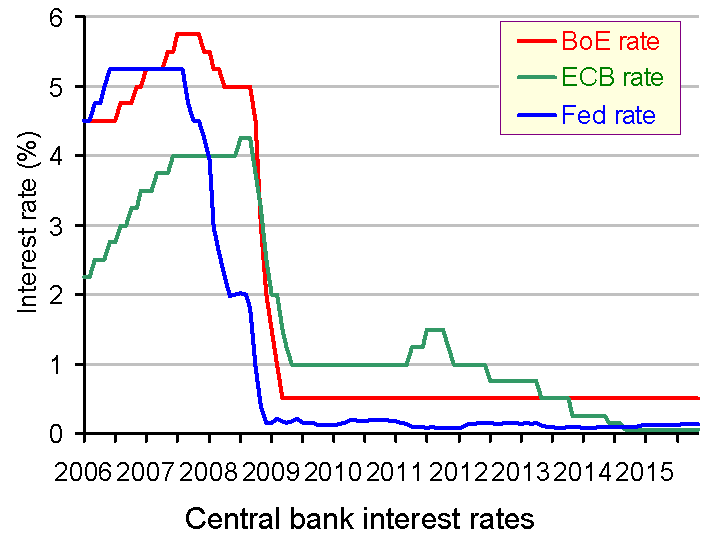
Interest rates can be a powerful tool in affecting the components of aggregate demand (AD) and hence the macroeconomic variables. If interest rates fall, it can help to stimulate AD by reducing borrowing costs for consumers and businesses, reducing the incentive to save, cutting variable rate mortgage payments and depreciating the exchange rate. Collectively these effects can stimulate an economy and hence create economic growth, reduce unemployment and push up prices. However, interest rates have been at almost 0% since the financial crisis, so the only way is up. Reversing the aforementioned effects could then spell trouble, if the economy is not in a sufficiently strong position.
For many, the strength of the US economy, while relatively good, is not yet good enough to justify a rate rise. It may harm investment, growth and unemployment and none of these variables are sufficiently high to warrant a rate rise, especially given the slowdown in the emerging markets. Karishma Vaswani, from BBC News said:
“The current global hand-wringing and head-holding over whether the US Fed will or won’t raise interest rates later has got investors here in Asia worried about what this means for their economies.
The Fed has become the favourite whipping boy of Asia’s central bankers, with cries from India to Indonesia to “just get on with it”.”
There are many, including Professor John Taylor from Stanford University and a former senior Treasury official, a rate rise is well over-due. The market is expecting one and has been for some time and these expectations aren’t going away, so ‘just get on with it.’ Janet Yellen, the Chair of the Federal Reserve is in a tricky situation. She knows that whatever is decided, markets around the world will react – no pressure then! The following articles consider the interest rate debate.
Articles
FTSE slides ahead of Fed interest rates decision The Telegraph, Tara Cunningham (17/9/15)
US’s interest rate rise dilemma BBC News, Andrew Walker (17/9/15)
US interest rate rise: how it could affect your savings and your mortgage Independent (17/9/15)
All eyes on Federal Reserve as it prepares for interest rate announcement The Guardian, Rupert Neate (16/9/15)
Federal Reserve meeting: Will US interest rates rise and should they? The Telegraph, Peter Spence (16/9/15)
Markets push US rate rise bets into 2016 as China woes keep Fed on hold: as it happened The Telegraph, Szu Ping Chan (17/9/15)
Federal Reserve puts rate rise on hold The Guardian (17/9/15)
US central bank leave interest rates unchanged BBC News (17/5/15)
Fed leaves interest rates unchanged Wall Street Journal, Jon Hilsenrath (17/9/15)
Asian markets mostly rally, US Futures waver ahead of Fed interest rate decision International Business Times, Aditya Tejas (17/9/15)
Data
Selected US interest rates Board of Governors of the Federal Reserve System (see, for example, Federal Funds Effective rate (monthly))
Questions
- What happened to US interest rates in September?
- Present the main arguments for keeping interest rates on hold.
- What were the arguments in favour of raising interest rates and do they differ depending on whether interest rates rise slowly or very rapidly?
- How did stock markets around the world react to Janet Yellen’s announcement? Is it good news for the UK?
- Using a diagram to support your explanation, outline why interest rates are such a powerful tool of monetary policy and how they affect the main macroeconomic objectives.
- Do you think other central banks will take note of the Fed’s decision, when they make their interest rate decisions in the coming months? Explain your answer.
 The US economy has been performing relatively well, but as with the UK economy, growth in the first quarter of 2015 has slowed. In the US, it has slowed to 0.2%, which is below expectations and said to be due to ‘transitory factors’. In response, the Federal Reserve has kept interest rates at a record low, within the band 0.0% to 0.25%.
The US economy has been performing relatively well, but as with the UK economy, growth in the first quarter of 2015 has slowed. In the US, it has slowed to 0.2%, which is below expectations and said to be due to ‘transitory factors’. In response, the Federal Reserve has kept interest rates at a record low, within the band 0.0% to 0.25%.
The USA appears relatively unconcerned about the slower growth it is experiencing and expects growth to recover in the next quarter. The Fed said:
“Growth in household spending declined; households’ real incomes rose strongly, partly reflecting earlier declines in energy prices, and consumer sentiment remains high. Business fixed investment softened, the recovery in the housing sector remained slow, and exports declined.”
Nothing has been said as to when interest rates may rise and with this unexpected slowing of the economy, further delays are likely. An investment Manager from Aberdeen Asset Management said:
“The removal of the Fed’s time dependent forward guidance could be significant. It means that any meeting from now on could be the one when they announce that magic first rate rise.”
Low rates will provide optimal conditions for stimulating growth. A key instrument of monetary policy, interest rates affect many of the components of aggregate demand. 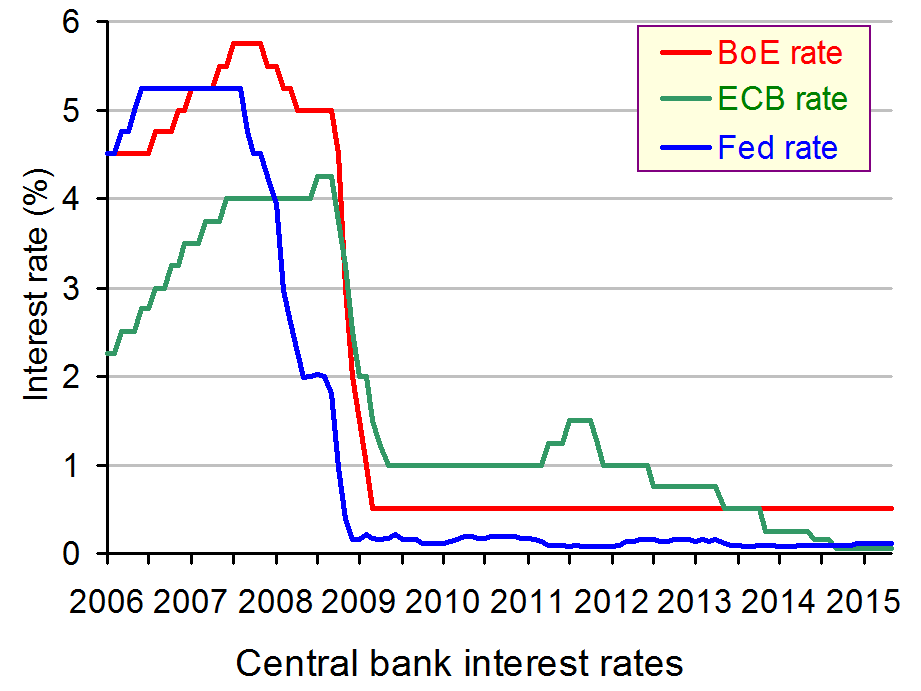 Lower interest rates reduce the cost of borrowing, reduce the return on savings and hence encourage consumption. They can also reduce mortgage repayments and have a role in reducing the exchange rate. All of these factors are crucial for any economic stimulus.
Lower interest rates reduce the cost of borrowing, reduce the return on savings and hence encourage consumption. They can also reduce mortgage repayments and have a role in reducing the exchange rate. All of these factors are crucial for any economic stimulus.
Analysts are not expecting rates to rise in the June meeting and so attention has now turned to September as the likely time when interest rates will increase and finally reward savers. Any earlier increase in rates could spell trouble for economic growth and similar arguments can be made in the UK and across the eurozone. The following articles consider the US economy.
Federal Reserve keeps interest rates at record low BBC News, Kim Gittleson (29/4/15)
Shock stalling of US economy hits chances of early Fed rate rise The Guardian, Larry Elliott (29/4/15)
US Fed leave interest rates unchanged after poor GDP figures Independent, Andrew Dewson (30/4/15)
Fed could give clues on first interest rate hike USA Today, Paul Davidson (28/4/15)
Fed’s downgrade of economic outlook signals longer rate hike wait Reuters, Michael Flaherty and Howard Schneider (29/4/15)
Five things that stopped the Fed raising rates The Telegraph, Peter Spence (29/4/15)
Questions
- By outlining the key components of aggregate demand, explain the mechanisms by which interest rates will affect each component.
- How can inflation rates be affected by interest rates?
- Why could it be helpful for the Fed not to provide any forward guidance?
- What are the key factors behind the slowdown of growth in the USA? Do you agree that they are transitory factors?
- Who would be helped and harmed by a rate rise?
- Consider the main macroeconomic objectives and in each case, with respect to the current situation in the USA, explain whether economic theory would suggest that interest rates should (a) fall , (b) remain as they are, or (c) rise.
 With the onset of the pandemic in early 2020, stock markets around the world fell dramatically, with many indices falling by 30% or more. In the USA, the Dow Jones fell by 37% and the Nasdaq fell by 30%. In the UK, the FTSE 100 fell by 33% and the FTSE 250 by 41%.
With the onset of the pandemic in early 2020, stock markets around the world fell dramatically, with many indices falling by 30% or more. In the USA, the Dow Jones fell by 37% and the Nasdaq fell by 30%. In the UK, the FTSE 100 fell by 33% and the FTSE 250 by 41%.
 The key question is what will investors believe. If they believe that share prices will continue to fall they are likely to sell. This has happened since early January, especially in the USA and especially with stocks in the high-tech sector – such stocks being heavily represented in the Nasdaq composite, a broad-based index that includes over 2500 of the equities listed on the Nasdaq stock exchange. From 3 January to 18 February the index fell from 15 833 to 13 548, a fall of 14.4%. But will this fall be seen as enough to reflect the current economic and financial climate. If so, it could fluctuate around this sort of level.
The key question is what will investors believe. If they believe that share prices will continue to fall they are likely to sell. This has happened since early January, especially in the USA and especially with stocks in the high-tech sector – such stocks being heavily represented in the Nasdaq composite, a broad-based index that includes over 2500 of the equities listed on the Nasdaq stock exchange. From 3 January to 18 February the index fell from 15 833 to 13 548, a fall of 14.4%. But will this fall be seen as enough to reflect the current economic and financial climate. If so, it could fluctuate around this sort of level. But a lot of this is second-guessing what other people will do – known as a Keynesian beauty contest situation. If people believe others will buy, they will too and this will push share prices up. If they think others will sell, they will too and this will push share prices down. They will all desperately wish they had a crystal ball as they speculate how people will interpret what central banks, governments and other investors will do.
But a lot of this is second-guessing what other people will do – known as a Keynesian beauty contest situation. If people believe others will buy, they will too and this will push share prices up. If they think others will sell, they will too and this will push share prices down. They will all desperately wish they had a crystal ball as they speculate how people will interpret what central banks, governments and other investors will do. Jeremy Grantham Doubles Down on Crash Call, Says Selloff Has Started
Jeremy Grantham Doubles Down on Crash Call, Says Selloff Has Started The monetary policy mandates of central banks have an impact on all our lives. While the terminology might not be familiar to many outside economics, their impact is, however, undeniably important. This is because they set out the objectives for the operation of monetary policy. Adjustments to interest rates or the growth of the money supply, which affect us all, reflect the mandate given to the central bank.
The monetary policy mandates of central banks have an impact on all our lives. While the terminology might not be familiar to many outside economics, their impact is, however, undeniably important. This is because they set out the objectives for the operation of monetary policy. Adjustments to interest rates or the growth of the money supply, which affect us all, reflect the mandate given to the central bank. Chart 1 shows the annual rate of consumer price inflation in the US since 1998. It helps to illustrate the concern that low inflation rates can become entrenched. The chart shows that, while the average inflation rate from 1998 to 2008 was 2.7 per cent, from 2009 the average has been only 1.6 per cent. Interestingly, the average since 2012, when the explicit 2 per cent goal was introduced, to the present day is also 1.6 per cent. (Click
Chart 1 shows the annual rate of consumer price inflation in the US since 1998. It helps to illustrate the concern that low inflation rates can become entrenched. The chart shows that, while the average inflation rate from 1998 to 2008 was 2.7 per cent, from 2009 the average has been only 1.6 per cent. Interestingly, the average since 2012, when the explicit 2 per cent goal was introduced, to the present day is also 1.6 per cent. (Click  Chart 2 shows the Federal Fund rate since 1998. This is the rate at which commercial banks lend to each other the reserve balances they hold at the Federal Reserve in order to meet their reserve requirements. The Federal Reserve can affect this rate through buying or selling government securities. If it wants to drive up rates, it can sell holdings of government securities and reduce the money supply. If it wants to drive rates down, it can buy government securities and increase the money supply. The effects then ripple through to other interest rates and, in turn, aggregate demand and inflation. (Click
Chart 2 shows the Federal Fund rate since 1998. This is the rate at which commercial banks lend to each other the reserve balances they hold at the Federal Reserve in order to meet their reserve requirements. The Federal Reserve can affect this rate through buying or selling government securities. If it wants to drive up rates, it can sell holdings of government securities and reduce the money supply. If it wants to drive rates down, it can buy government securities and increase the money supply. The effects then ripple through to other interest rates and, in turn, aggregate demand and inflation. (Click 

